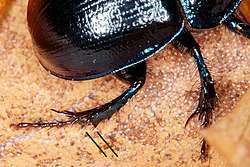Anoplotrupes stercorosus
Anoplotrupes stercorosus, the dor beetle, is a species of earth-boring dung beetle belonging to the family Geotrupidae, subfamily Geotrupinae.
| Anoplotrupes stercorosus | |
|---|---|
| Anoplotrupes stercorosus, upperside | |
 | |
| Side view | |
| Scientific classification | |
| Kingdom: | |
| Phylum: | |
| Class: | |
| Order: | |
| Family: | |
| Genus: | |
| Species: | A. stercorosus |
| Binomial name | |
| Anoplotrupes stercorosus (Hartmann in L. G. Scriba, 1791) | |
| Synonyms | |
|
List
| |

Varieties
Varieties or forms that have been recognized at times include the following:[1]
- A. stercorosus var. viridis (Dalla Torre, 1879)
- A. stercorosus var. amoethystinus (Mulsant, 1842)
- A. stercorosus var. nigrinus (Mulsant, 1842)
- A. stercorosus ab. juvenilis (Mulsant, 1842)
These are now regarded as synonyms of the parent taxon;[2] the International Code of Zoological Nomenclature does not recognize named forms other than subspecies.
Distribution
This beetle is present throughout Europe (Albania, Andorra, Austria, Belarus, Belgium, Bosnia and Herzegovina, Bulgaria, Corsica, Croatia, Czech Republic, Denmark, Estonia, Finland, France, Germany, Greece, Hungary, Ireland, Italy, Latvia, Lithuania, Liechtenstein, Luxembourg, Montenegro, Netherlands, Norway, Poland, Portugal, Romania, Russia, Serbia, Slovakia, Slovenia, Spain, Sweden, Switzerland, Turkey, Ukraine, United Kingdom).[3]
Habitat
These beetles inhabit fresh areas of broadleaf forests, mainly beech forests; moist mixed forest; and fresh coniferous forests.[4][5]
Description
The adults of A. stercorosus grow up to 12–20 millimetres (0.47–0.79 in) long [4][6] and therefore they do not reach the length of the very similar common dung beetle (Geotrupes stercorarius). The body colour is blue-black, while the underside is usually metallic blue. The elytra have seven longitudinal slightly dotted grooves. The wings may be blue, violet or green. Antennae are reddish brown. Geotrupes stercorarius presents three keels on the outer side of the tibia of the third pair of legs, while A. stercorosus presents only two.
Biology
Adults can be encountered from June through the following spring.[4] These dung beetles feed on feces, rotting fungi and tree sap. In spring they lay eggs in chambers at the end of a corridor dug in the soil that is approximately 70–80 centimetres (28–31 in) long, in which feces of herbivorous and omnivorous animals are placed to feed the larvae. They may also feed on litter mold, decomposing fungi and Phallus impudicus.[4] The larvae overwinter and pupate in spring, requiring a year to complete the whole process.[4]
Gallery
- Anoplotrupes stercorosus moving feces
.jpg) Taking flight
Taking flight- Museum specimen
Bibliography
- Anderson, R., Nash, R. & O'Connor, J. P. 1997, Irish Coleoptera: a revised and annotated list, Irish Naturalists' Journal Special Entomological Supplement, 1-81
- Joy, N. H., 1932, A practical handbook of British beetles, H. F. & G. Witherby, London
- Jessop, L., 1986, Coleoptera: Scarabaeoidea. Dung beetles and chafers
- Mann, D., 2002, Geotrupidae in: Checklist of Beetles of the British Isles. www.coleopterist.org.uk
- Mulsant E. (1842) Histoire naturelle des Coléoptères de France. Lamellicornes, Paris, Lyon :1-623
- Scriba L.G. (1791) Entomologische Bemerkungen und Erfahrungen, Journal für die Liebhaber der Entomologie. Frankfurt 1(3):244-255
References
| Wikispecies has information related to Anoplotrupes stercorosus |
| Wikimedia Commons has media related to Anoplotrupes stercorosus. |
- Biolib
- "Catalogue of Life : Anoplotrupes stercorosus (Scriba, 1791)". www.catalogueoflife.org. Retrieved 2019-08-16.
- Fauna europaea
- Commanster
- Adam Byk, Piotr Semkiw. Habitat preferences of the forest dung beetle Anoplotrupes stercorosus (Scriba, 1791) (Coleoptera:Geotrupinae) in Białowieża Forest. Acta Sci. Pol. Silv. Colendar. Rat. Ind. Lig nar. 9 (3-4), s. 17-28, 2010.
- Atlas of Geotrupidae of Russia